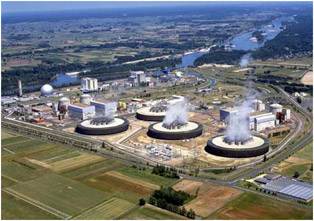Mamuka Abuladze, www.european.ge
On June 13, 2007, during his meeting with the French President Nikola Sarkozy in Paris, Georgian President Mikheil Saakashvili first announced the decision of the government of Georgia about construction of nuclear electro-station in Georgia. After the meeting, Sarkozy said France was ready to discuss economical and ecological rationale of the project, thus indicating that France was ready to evaluate construction project of the nuclear electro-station in Georgia.
Next day, Saakashvili met executive director of the leading energy company AREVA of France to discuss the perspectives of the construction of nuclear electro-station. According to that time statements of Georgian diplomats, consultations had already been launched on the experts’ level for the farther perfection and accomplishment of the project. On August 16, 2007 commission for the evaluation of construction of nuclear electro-station was set up at the government session with the Ministry of Energy as a commission head and representatives of ministers’ cabinet and independent experts as commission members.
The Law of Georgia about Nuclear and Radiation Safety, drafted by the Green Party in 1998 which acted until now, did not allow the Government of Georgia to peacefully use the nuclear energy. The government could not issue license on the construction of the third generation nuclear electro-station because the Article 5 of the law prohibited export, import, transit and re-export, research, examine and possession of nuclear weapon and explosives, radioactive remains and fuel; to operate the enterprise working on high-voltage nuclear energy and to conduct researches of similar power, to import radioactive substances for their farther processing, storage and other purposes. The Law had declared Georgia to be a country free from nuclear facilities, technologies and radioactive remains; thus in order to implement the project of nuclear electro-station construction the government has successfully amended the law and adopted the “new” law in 2012 which already allows:
• Construction of nuclear facilities including nuclear stations;
• re-export of radioactive remains;
• export, import, transport and re-export of nuclear weapon or other nuclear explosives’
Thus, our government has inevitably decided to construct nuclear electro-station ion Georgia though there are more than enough hydro resources in our country to supply not only Georgian population with electricity but even to export it too.
Where will nuclear reactors be constructed in the Georgian territory? To answer the question we tried to estimate where the required amount of water resource for the technological cycling of the nuclear electro-station was located in the country.
A large amount of heat produced by chain nuclear reaction in the reactors of nuclear electro-stations will boil water whose steam circulates turbines of electro-generator. Modern models of nuclear electro-stations use water for two purposes:
1. to transfer heat to active zone of reactor to steam turbine;
2. to release extra heat from steam cycle in the environment.
The bigger is difference between internal source of heat and outside temperature, the more heat energy is transferred into mechanic energy and will circulate the generator in this particular case. Thus, they should choose the condition when temperature inside the reactor is highest possible and the temperature outside is the lowest possible. The location for similar electro-stations is selected according to these requirements where there is enough amount of cold water. For example, efficiency of the planned nuclear electro-station in Turkey will be 1% more if it uses Black Sea water instead the Mediterranean Sea which has warmer water.
1. cycle of transferring heat from reactor nucleus to generator is closed, water initially turns into steam which turns turbine of the electro-generator, then it turns back into water and flows back to the reactor; so insignificant amount of water is wasted but despite that, the station must be periodically supplied with clean and extremely clean water.
Unlike steam-electro stations, the nuclear electro-stations require additional amount of water: if the steam source is eternally liquidated after the steam electro-station is closed, in the case of nuclear electro-station the radioactive dismantling still continues and heat is produced; so guaranteed cooling possibility must necessarily exist both for the daily routine work and for the cooling during emergency situation in the active zone. Georgia’s location in seismically active zone requires creation of particular mechanisms to protect the nuclear electro-stations from natural disasters (earthquakes) and it includes availability of extra huge supply of water in case of accident on the reactor.
2. second function of the water in the nuclear electro-station is release of extra heat in the environment which was produced during condensation of circulating steam in the closed cycle between the reactor and turbine. Due to internal restriction of transformation of heat into mechanic energy, in modern steam and nuclear stations the loss of heat energy amounts to almost two-third. Thus, the necessary requirement for the construction of similar stations is to prevent extra heat into atmosphere or in the water-reservoir. For example in Great Britain nuclear stations are located 2 kilometers away from the Sea and Lakes.
There are three ways to cool steam for condensation:
Direct cooling is the easiest way when electro-station is located on the sea-shore, on the river bank or close to big lake. Large amount of water flows into the station from the station and then warmed water returns back to the reservoir. Only small amount of used water is evaporated in the atmosphere. In Great Britain the nuclear station of 1600 MWe uses 90 cubic meter of water per second working with the abovementioned cooling system. Besides that, if the water temperature in the reservoir exceeds 28-32 degrees, additional cooling technologies are used. Even salty sea water can also be used for this method of cooling.
Recirculation or indirect cooling: when huge amount of water is not available, water flows through condensate pipes, which cools at the expense of evaporated water drops. 3-5% of the used water in this particular case is lost as a steam and it should be permanently re-supplied from the nearby channel or river. It is the most spread method of using water for cooling. In Great Britain nuclear electro-station with the power of 1 600 MWe uses 2 cubic meters of water per second. As for the effect on the environment, nuclear stations with this cooling system are more economical and thus it is considered to be the best technology but requires more resources of fresh water: 1.8 liter of water for 1 kilowatt produced electricity while only 0.4 liter is used for 1kwt produced electricity in case of direct cooling system.
In France, 15 nuclear electro-stations (32 reactors) use fresh water for steam cooling and only 4 nuclear stations (12 reactors) use direct method and gets water supply directly from the water-reservoir.
Dry cooling: in some nuclear electro-stations circulating steam is cooled without usage of steaming effect and by directly surrounding air like it happens in the radiator of a car; cooling towers are constructed for this purpose. This method of cooling is less effective than water-cooling.
According to the 2006 survey of the US Ministry of Energy, 60 out of total 104 nuclear stations use direct cooling method; 35 of them use drop steaming method and nine two-process combined systems. The same correlation is in Russia and Europe.
Modern so-called III+ generation reactor EPRtm produced by the French Energo-Company AREVA is one of the most powerful in the world and produces 1 650 MWe electricity; it is cooled by sub-supply of water flow. If even one electro-station with similar reactor is constructed in Georgia, it will require at least 160 mega liter of fresh water in 24 hours.
Two rivers in Georgia are so abundant that it would be impossible to get water from without causing serious ecological damage:
Rioni – abundant river in Georgia which flows through the territory of whole country and the average annual expenditure at Sakochikidze is 406 m³/sec;
Mtkvari – the annual average expenditure of which is 402 m³/sec at Mingechauri.
Let us see the map of seismologic danger of Georgia. We will find out that it is possible to pick the territories near these rivers where the micro seismologic intensity is lower. This is a spot on left side of Rioni at Kolkheti valley and left side of Mtkvari on Kvemo Kartli plain.
Thus, considering two important parameters (possibility of getting water and seismology), we can assume that for the location of nuclear power-station reactors the following territories would be selected: Gardabani region, Poti-Senaki-Samtredia-Lanchkhuti and southern part of Rombi.
What dangers does this project bring to local population?
It is virtually impossible to fully isolate radioactive substances from biosphere while the functioning of nuclear objects. The environment can be polluted by the following substances 85Kr, 138Xe , 41Ar , 14C and other aerosols the small percentage of which leak in the atmosphere.
In order to demonstrate the insignificance of danger of ionization radiation the average annual individual dose of radiation 10-7 is compared to the dose received through natural radiation: 170.10-5 sievert. But, how safe is this “insignificant,” additional radiation for humans?
In order to assess the genetic danger of ionization the so-called “unlimited concept” has been developed which implies that all kinds even the smallest dose of radiation increases the risk of development of genetic problems. Increase of development of mutations, as well as increase of malignant tumors is not swiftly revealed and it can inflict serious damage on future generations. If the body adult has certain mechanisms to fight the side effects of radiation, these mechanisms are weak in children. As for the human embryo, it is completely unprotected towards the ionization radiation.
One more serious problem of exploitation of nuclear power-station is the local and regional climate changes caused by their impact on environment. Thermal efficiency of modern atomic power-stations depending on their location is between 34-36% (maximum 39%). This means that this part of energy developed in nuclear reactor turns into mechanism (later, electronic) energy, the rest goes to atmosphere. In winter, because of increase of temperature difference between the environment and reactor, nuclear stations produce more warms than in summer. Launching new atomic power-station in Caucasus will add on exhaustion of biosphere reserve and creation of “Thermal Island” in the region which might result in severe climate anomalies.
Besides the abovementioned, development of thermal energy which is deemed essential by the current government will cause many other ecological and social negative effects. That is why it is time to start serious discussion on the topic: Is it work to sit on atomic mine after witnessing Chernobyl and Fukushima disasters?!




